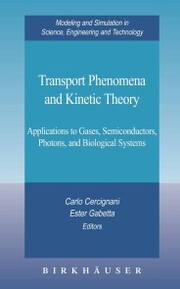Detailansicht
Transport Phenomena and Kinetic Theory
eBook - Applications to Gases, Semiconductors, Photons, and Biological Systems, Modeling and Simulation in Science, Engineering and Technology
ISBN/EAN: 9780817645540
Umbreit-Nr.: 1801833
Sprache:
Englisch
Umfang: 271 S., 3.54 MB
Format in cm:
Einband:
Keine Angabe
Erschienen am 03.12.2007
Auflage: 1/2007
E-Book
Format: PDF
DRM: Digitales Wasserzeichen
- Zusatztext
- This volume aims to provide an overview of some recent developments of mathematical kinetic theory focused on its application in modelling complex systems in various ?elds of applied sciences. Mathematical kinetic theory is essentially based on the Boltzmann eq- tion, which describes the evolution, possibly far from equilibrium, of a class of particles modelled as point masses. The equation de?nes the evolution in time and space of the distribution function over the possible microscopic states of the test particle, classically position and velocity. The test particle is subject to pair collisions with the ?eld particles. The interested reader can ?nd in the book, Theory and Application of the Boltzmann Equation, by C. Cercignani, R. Illner, and M. Pulvirenti, Springer, Heidelberg, 1993, all necessary knowledge of the physics and mathematical topics related to this celebrated model of non-equilibrium statistical mech- ics. Another important model of mathematical kinetic theory is the Vlasov equation, where interactions between particles are not speci?cally collisions, but mean ?eld actions of the ?eld particles over the test particle. The model de?nes again an evolution equation for the one-particle distribution function over the microscopic state of the test particle. The two models brie?y mentioned above can be regarded as the fun- mental models of mathematical kinetic theory and the essential background o?ered from the kinetic theory for classical particles towards the modelling of large systems of several particles undergoing non classical interactions.
